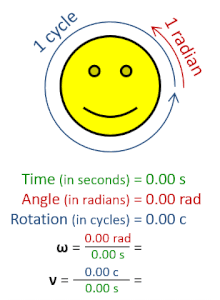Angular frequency: Difference between revisions
No edit summary |
cleared up confusion between ν (nu) and v (vee) |
||
| Line 1: | Line 1: | ||
{{Distinguish|angular velocity}} |
{{Distinguish|angular velocity}} |
||
[[Image:AngularFrequency.gif|thumb|Angular frequency [[omega|ω]] (in radians per second), is larger than frequency |
[[Image:AngularFrequency.gif|thumb|Angular frequency [[omega|ω]] (in radians per second), is larger than frequency ν (in cycles per second, also called [[Hertz|Hz]]), by a factor of 2π. This figure uses the symbol ν, rather than f to denote frequency.]] |
||
In [[physics]], '''angular frequency''' ω (also referred to by the terms '''angular speed''', '''radial frequency''', '''circular frequency''', '''orbital frequency''', '''radian frequency''', and '''pulsatance''') is a scalar measure of rotation rate. Angular frequency (or angular speed) is the magnitude of the vector quantity ''[[angular velocity]]''. The term '''angular frequency vector''' <math>\vec{\omega}</math> is sometimes used as a synonym for the vector quantity angular velocity.<ref name=UP1>{{cite book |
In [[physics]], '''angular frequency''' ω (also referred to by the terms '''angular speed''', '''radial frequency''', '''circular frequency''', '''orbital frequency''', '''radian frequency''', and '''pulsatance''') is a scalar measure of rotation rate. Angular frequency (or angular speed) is the magnitude of the vector quantity ''[[angular velocity]]''. The term '''angular frequency vector''' <math>\vec{\omega}</math> is sometimes used as a synonym for the vector quantity angular velocity.<ref name=UP1>{{cite book |
||
| last = Cummings |
| last = Cummings |
||
| Line 38: | Line 38: | ||
:''T'' is the [[Frequency|period]] (measured in [[second]]s), |
:''T'' is the [[Frequency|period]] (measured in [[second]]s), |
||
:''f'' is the [[frequency|ordinary frequency]] (measured in [[hertz]]) (sometimes symbolised with [[nu (letter)|ν]]), |
:''f'' is the [[frequency|ordinary frequency]] (measured in [[hertz]]) (sometimes symbolised with [[nu (letter)|ν]]), |
||
The animated gif shows v = Hz. It should be an f for frequency. The tangential velocity is expressed as v and is not shown in the animation as it requires a radius reference. |
|||
==Units== |
==Units== |
||
In [[SI]] units, angular frequency is normally presented in [[radian]]s per [[second]], even when it does not express a rotational value. From the perspective of [[dimensional analysis]], the unit [[Hertz]] (Hz) is also correct, but in practice it is only used for ordinary frequency ''f'', and almost never for ω. This convention helps avoid confusion.<ref>{{cite book| url=http://books.google.com/books?id=eJhkD0LKtJEC&pg=PA145| title= Physics for scientists and engineers| first=Lawrence S.|last= Lerner|page=145| isbn=978-0-86720-479-7| date=1996-01-01}}</ref> |
In [[SI]] units, angular frequency is normally presented in [[radian]]s per [[second]], even when it does not express a rotational value. From the perspective of [[dimensional analysis]], the unit [[Hertz]] (Hz) is also correct, but in practice it is only used for ordinary frequency ''f'', and almost never for ω. This convention helps avoid confusion.<ref>{{cite book| url=http://books.google.com/books?id=eJhkD0LKtJEC&pg=PA145| title= Physics for scientists and engineers| first=Lawrence S.|last= Lerner|page=145| isbn=978-0-86720-479-7| date=1996-01-01}}</ref> |
||
Revision as of 14:32, 23 April 2013

In physics, angular frequency ω (also referred to by the terms angular speed, radial frequency, circular frequency, orbital frequency, radian frequency, and pulsatance) is a scalar measure of rotation rate. Angular frequency (or angular speed) is the magnitude of the vector quantity angular velocity. The term angular frequency vector is sometimes used as a synonym for the vector quantity angular velocity.[1]
One revolution is equal to 2π radians, hence[1][2]
where
- ω is the angular frequency or angular speed (measured in radians per second),
- T is the period (measured in seconds),
- f is the ordinary frequency (measured in hertz) (sometimes symbolised with ν),
Units
In SI units, angular frequency is normally presented in radians per second, even when it does not express a rotational value. From the perspective of dimensional analysis, the unit Hertz (Hz) is also correct, but in practice it is only used for ordinary frequency f, and almost never for ω. This convention helps avoid confusion.[3]
In digital signal processing, the angular frequency may be normalized by the sampling rate, yielding the normalized frequency.
Examples

Circular motion
In a rotating or orbiting object, there is a relation between distance from the axis, tangential speed, and the angular frequency of the rotation:
Oscillations of a spring
| Part of a series on |
| Classical mechanics |
|---|
An object attached to a spring will oscillate. Assuming that the spring is ideal and massless with no damping then the motion will be simple and harmonic with an angular frequency given by:[4]
where
- k is the spring constant
- m is the mass of the object.
ω is referred to as the natural frequency (which can sometimes be denoted as ω0).
As the object oscillates, its acceleration can be calculated by
where x is displacement from an equilibrium position.
Using 'ordinary' revolutions-per-second frequency, this equation would be
LC circuits
The resonant angular frequency in an LC circuit equals the square root of the inverse of capacitance (C measured in farads), times the inductance of the circuit (L in henrys).[5]
See also
References and notes
- ^ a b Cummings, Karen (Second Reprint: 2007). Understanding physics. New Delhi: John Wiley & Sons Inc., authorized reprint to Wiley - India. pp. 449, 484, 485, 487. ISBN 978-81-265-0882-2.
{{cite book}}: Check date values in:|date=(help); Unknown parameter|coauthors=ignored (|author=suggested) (help)(UP1) - ^ Holzner, Steven (2006). Physics for Dummies. Hoboken, New Jersey: Wiley Publishing Inc. p. 201. ISBN 978-0-7645-5433-9.
{{cite book}}: Cite has empty unknown parameter:|coauthors=(help) - ^ Lerner, Lawrence S. (1996-01-01). Physics for scientists and engineers. p. 145. ISBN 978-0-86720-479-7.
- ^ Serway,, Raymond A. (2006). Principles of physics - 4th Edition. Belmont, CA.: Brooks / Cole - Thomson Learning. pp. 375, 376, 385, 397. ISBN 978-0-534-46479-0.
{{cite book}}: Unknown parameter|coauthors=ignored (|author=suggested) (help)CS1 maint: extra punctuation (link) - ^ Nahvi, Mahmood (2003). Schaum's outline of theory and problems of electric circuits. McGraw - Hill Companies (McGraw - Hill Professional). pp. 214, 216. ISBN 0-07-139307-2.
{{cite book}}: Unknown parameter|coauthors=ignored (|author=suggested) (help)(LC1)
Related Reading:
- Olenick ,, Richard P. (2007). The Mechanical Universe. New York City: Cambridge University Press. pp. 383–385, 391–395. ISBN 978-0-521-71592-8.
{{cite book}}: Unknown parameter|coauthors=ignored (|author=suggested) (help)CS1 maint: extra punctuation (link)








